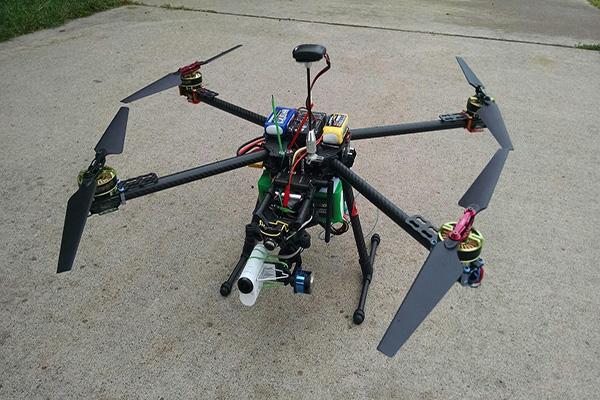Ryan Francis, a third-year powerline maintenance student, flies things for fun. Not kites, not Air Hog toys—well, at least not anymore.
Francis’s current endeavors involve thousands of dollars worth of carbon fiber and high-amperage battery power. He began with a toy quadcopter, something available for about $30, in order to get a handle for flight controls and how outside factors affect the flight of something with three or four propellers. He has since upgraded to bigger and better machines of lightweight construction and high-powered motors, with one of them capable of topping 70 miles per hour.
“I have a tricopter (that’s three propellers) racer, which is the fast one,” Francis said. “I fly it using a screen display to guide me, since it’s hard to spot when it zips overhead going that fast. You’ll hear it before you see it—this one screams when it’s at top speed.”
He went on to explain that although he has one “drone” built for racing, there isn’t exactly a lot of competition to race around these parts. “I pretty much just take it out for fun,” he said.
His other drone, a quadcopter deal capable of carrying a pro-level digital camera, is the one he used to take the shots featured in last week’s center spread.
Generally, he uses a Sony ActionCam to conserve weight and prolong the flight time—smaller and lighter than a GoPro, and just as capable.
“Weight is everything in this game,” Francis said. “The more weight on the machine, the faster the battery dies and the less responsive it is to maneuver.”
Flight time and maneuverability are huge when flying over crowds and thoroughfares, and drones are becoming more popular as a method of recording concerts and other big-number events.
The machines can achieve angles and perspectives that a human normally couldn’t, and are a huge aid to event photographers when they’re allowed.
As far as cost, the machines themselves can be had for a relatively accessible price point. The smaller drone Francis built cost him about $100; he also built the larger one himself, but he searched for deals and assembled it for way below normal cost.
“If I had paid full price for everything, like some people do, I’d be into $1,500.”
But that’s for a top-end drone with serious power and flying time—Francis doesn’t recommend anything near that caliber for a beginner.
“I started on a toy-grade drone from Wal-Mart, an Air Hog actually,” he said. “I learned the basics first, and worked my way up. These things can break windows and slice fingers, or crash themselves and cost you a lot of money if you don’t know what you’re doing.”
The use of a camera in drone and remote-controlled flight is another issue entirely; Francis said he had dealt with a handful of people threatening to shoot the thing down, camera or no camera.
“There’s a mentality toward these things, you know? People are afraid of being spied on.” Francis shook his head as he told the story of a neighbor yelling if he ever saw “that thing” flying over his house again he’d get out his gun.
“Now, you know, this is L’Anse we’re talking about,” Francis said, laughing, “but still. Around here, I don’t have any problems. If anything, the common reaction is having people come up to me saying how awesome the drone is. Lots of enthusiasm.”
Francis would like to extend an offer for anyone on campus interested in building or flying tri- and quadcopters to get in touch with him through email at [email protected].























